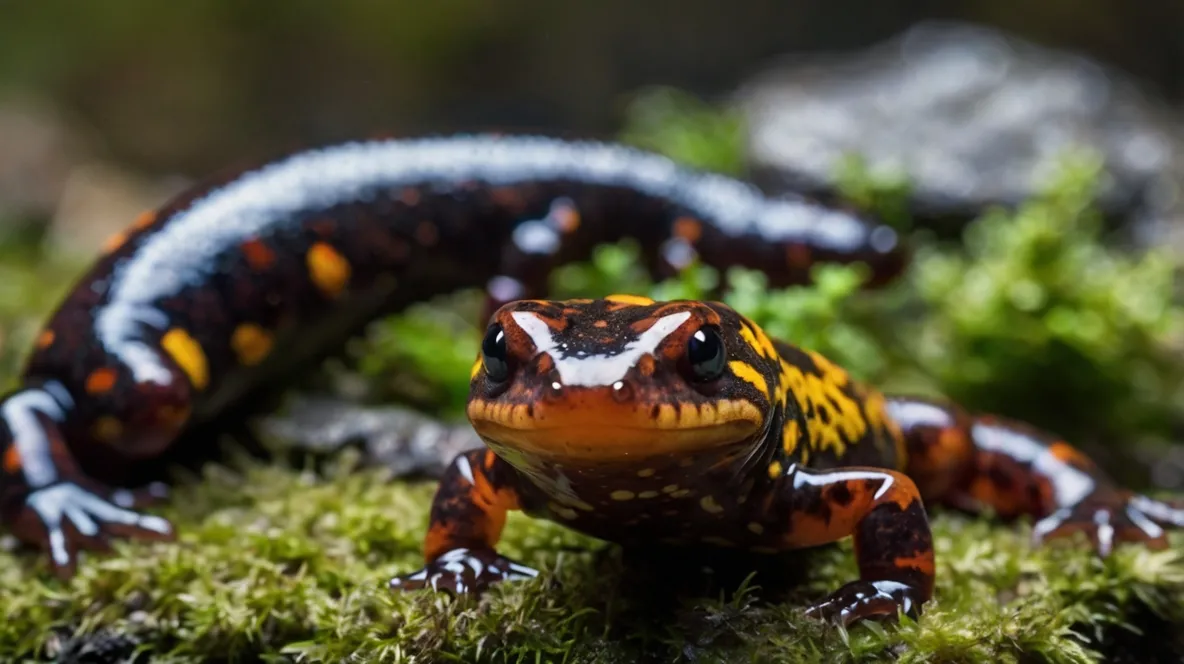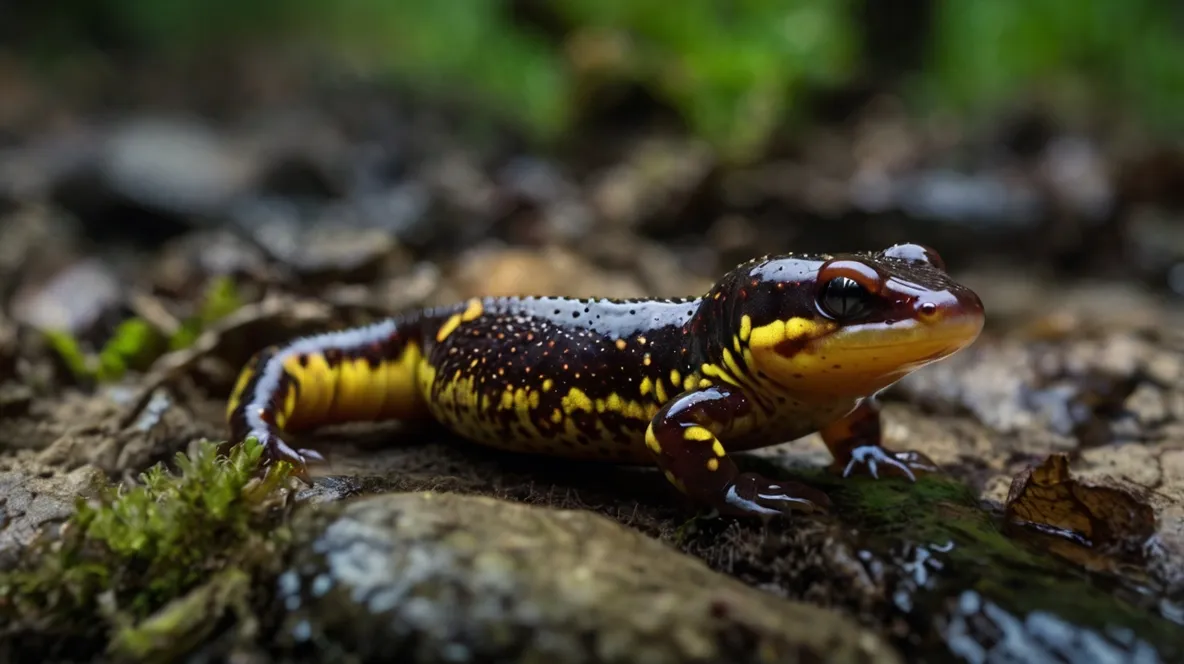Salamander Medical Information & Health Guide
Understanding Salamander Health
Salamanders, like other amphibians, have sensitive, permeable skin and specific environmental needs related to temperature, humidity, and substrate. Their health is directly linked to the quality of their captive environment. Stress, poor hygiene, improper temperatures, and inadequate diet are common precursors to illness. This information is for general guidance and cannot replace professional veterinary care. Always consult a vet experienced with amphibians if you suspect your salamander is unwell.

Common Salamander Health Issues
Knowing potential problems aids in prevention and early detection.
- Bacterial Infections (Septicemia, “Red Leg”): Often opportunistic, arising from stress, injuries, or suboptimal conditions (poor hygiene, wrong temp/humidity). Various bacteria can cause systemic infections.
- Symptoms: Skin redness (especially limbs and underside), lethargy, anorexia, skin ulcers, edema (bloating), rapid decline.
- Prevention: Maintain immaculate enclosure hygiene (regular substrate changes, spot cleaning), provide correct temperature and humidity, ensure clean water source (dechlorinated), avoid overcrowding, minimize stress.
- Note: Requires immediate veterinary attention for diagnosis and antibiotic treatment. Often fatal if not caught early.
- Fungal Infections: Can affect the skin, especially if stressed, injured, or kept in overly damp, stagnant conditions without proper drainage or ventilation. Saprolegnia (water mold) can affect aquatic species/larvae.
- Symptoms: White, cottony patches on skin (especially Saprolegnia), skin discoloration, lethargy, anorexia.
- Prevention: Ensure proper humidity but avoid constantly waterlogged substrate, provide good drainage and some ventilation, maintain appropriate temperatures, quarantine new arrivals.
- Note: Needs veterinary diagnosis and treatment with antifungal medications. Address husbandry flaws.
- Chytridiomycosis (Chytrid Fungus – Bd and Bsal): *Batrachochytrium dendrobatidis* (Bd) and *Batrachochytrium salamandrivorans* (Bsal) are serious fungal pathogens affecting amphibians. Bsal is particularly devastating to salamanders.
- Symptoms (can be vague): Lethargy, anorexia, abnormal skin shedding, skin ulcers/lesions (especially with Bsal), abnormal posture, rapid weight loss.
- Prevention: EXTREME caution and quarantine (90+ days) are vital, especially for European species susceptible to Bsal. Source animals from reputable, possibly tested breeders. Strict biosecurity: never share equipment, disinfect everything, avoid contact with wild amphibians or potentially contaminated materials.
- Note: Diagnosis via PCR testing by a vet. Treatment exists (antifungal baths, heat treatment sometimes used) but prognosis can be poor, especially with Bsal. Bsal is a major conservation threat.
- Parasites (Internal & External): Internal worms (nematodes, trematodes) and protozoa can occur. External parasites like mites or leeches are less common in typical captive setups but possible.
- Symptoms (Internal): Weight loss, lethargy, anorexia, bloating, abnormal feces (if visible).
- Symptoms (External): Visible parasites on skin (rare).
- Prevention: Quarantine new animals, maintain good hygiene, source captive-bred animals, regular fecal exams by vet can be useful.
- Note: Requires veterinary diagnosis (fecal analysis) and specific antiparasitic treatment.
- Metabolic Bone Disease (MBD): Less common than in reptiles but can occur with prolonged improper diet lacking calcium or Vitamin D3, or if feeder insects aren’t properly supplemented.
- Symptoms: Lethargy, weakness, rubbery jaw, thin limbs, reluctance to move, possible tremors.
- Prevention: Dust feeder insects (crickets, worms, roaches) with a quality amphibian vitamin/mineral supplement containing calcium and D3 according to a proper schedule. Offer a varied diet.
- Note: Diagnosis and treatment by a vet, involving dietary correction and potentially calcium/vitamin supplementation.
- Impaction: Blockage of the digestive system, usually from ingesting substrate (gravel, large wood chips) accidentally while feeding.
- Symptoms: Lethargy, anorexia, bloating, lack of feces.
- Prevention: Use fine-particle substrates (coco fiber, organic topsoil) or textures less likely to be ingested (large, smooth items, moss). Feed in a separate container or designated clean area if substrate ingestion is a concern.
- Note: Mild cases might pass with appropriate conditions. Severe cases may require veterinary intervention.
- Toxicity: Highly sensitive to chemicals absorbed through the skin (soaps, lotions, cleaning agents, pesticides, tap water chlorine/chloramine).
- Symptoms: Spasms, paralysis, lethargy, skin irritation/burns, sudden death.
- Prevention: Always handle with clean, thoroughly rinsed, powder-free wet gloves or wet hands (if unavoidable). Use only dechlorinated or spring water. Keep enclosure away from household chemicals/aerosols.
- Note: If suspected, move to a clean, safe setup with appropriate water immediately and contact a vet. Often has a poor prognosis.
- Heat Stress: Most salamanders require cool temperatures. Temperatures considered normal room temp for humans can be lethally hot for many salamander species.
- Symptoms: Lethargy, gaping, sticking to cooler surfaces (glass), frantic attempts to escape, death.
- Prevention: Research specific species’ temperature needs. Keep enclosure in a cool part of the house, potentially a basement. Use cooling methods (fans evaporating water, AC) if necessary. Monitor temperatures closely.
- Note: Can cause rapid decline. Immediate cooling measures are necessary, but avoid thermal shock.
Proactive Husbandry for Salamander Health
Good care focuses on replicating their cool, moist, and clean natural habitats.

- Cool Temperatures: Crucial for most species. Often requires keeping them in cooler rooms or basements (typically 60-70°F, some species even cooler). Avoid heat sources unless specifically needed for a basking spot for certain species (rare).
- High Humidity & Moisture: Maintain appropriate humidity via misting, moist substrate, and covered ventilation. Substrate should be damp but not waterlogged. Provide a clean, shallow water dish with dechlorinated water.
- Suitable Substrate: Use moisture-retaining substrates like coco fiber, organic topsoil (no chemicals/fertilizers), sphagnum moss, or leaf litter. Ensure adequate depth for burrowing species.
- Hides & Security: Provide ample hiding places (cork bark, logs, caves, deep substrate) to reduce stress.
- Cleanliness: Spot clean waste regularly. Perform partial or full substrate changes periodically depending on setup type (bioactive vs. traditional). Keep water dish clean.
- Diet & Supplementation: Offer a varied diet of appropriate live feeders (earthworms, crickets, roaches, etc.). Dust non-worm feeders with calcium/D3 supplement regularly.
- Quarantine: Isolate new salamanders rigorously for at least 60-90 days due to risks like Chytrid fungus. Maintain strict biosecurity.
- Gentle Handling: Handle as little as possible. Always use clean, wet, powder-free gloves or thoroughly rinsed wet hands.
General Signs of Illness in Salamanders
Observe for these signs and consult an amphibian vet if noted:
- Lethargy, hiding excessively, lack of movement
- Refusal to eat
- Weight loss, thinness
- Skin problems: redness, sores, ulcers, fuzzy patches, abnormal shedding
- Bloating (edema)
- Cloudy eyes
- Weakness, difficulty moving, abnormal posture
- Visible parasites
- Staying constantly submerged in water (if primarily terrestrial) or avoiding water (if aquatic/semi-aquatic)
- Excessive mucus production
Finding an Amphibian-Savvy Veterinarian
Experience with amphibians is crucial for proper diagnosis and treatment.
- Prioritize Amphibian Experience: Look specifically for vets known to treat salamanders and other amphibians, not just general exotics or reptiles.
- Consult Amphibian Communities: Online forums, local societies, and experienced keepers are often the best source for vet recommendations.
- ARAV May Help: The Association of Reptilian and Amphibian Veterinarians directory is a potential resource.
- Ask About Diagnostics: When calling clinics, inquire about their ability to perform skin scrapes, fecal exams, and potentially Bd/Bsal testing.
- Prepare for the Visit: Bring photos of the animal and setup, detailed husbandry information (temps, humidity, substrate, diet, cleaning schedule), and transport the salamander safely in a cool, moist, secure container.